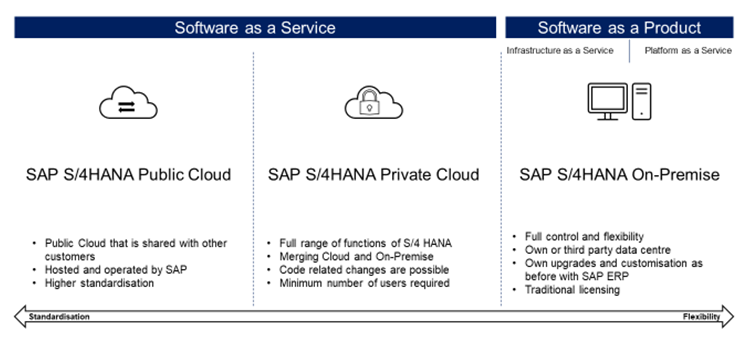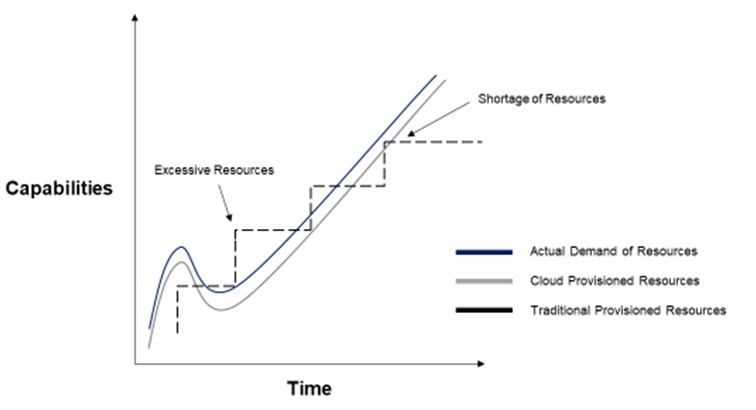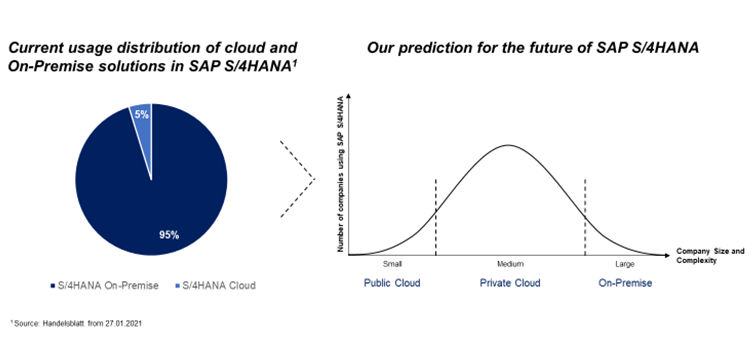Cloud vs. On-Premise
Private Cloud: The new gold standard for SAP S/4HANA?
Before migrating an existing SAP solution to S/4HANA or implementing it from scratch, companies face the challenge to choose the adequate deployment option that best fits the business needs and process landscape. While in the former SAP ERP system the On-Premise solution was more or less the only way to go, this shifts with SAP S/4HANA. Companies now can choose out of three deployment options that all have their specific benefits and might be reasonable to use depending on the company’s requirements: the On-Premise version and two cloud versions, one as a private cloud and one as a public cloud.

Figure 1 Deployment Options for SAP S/4HANA
Cloud solutions vs. traditional solutions
Apart from SAP, cloud solutions generally have an advantage in terms of the return on invested capital (ROI) which is illustrated in figure 2. Since cloud services are paid per usage of the corresponding resources, there are relatively low up-front costs and, thus, no capital investment is required before using the solution. Also, the capital expenditure for infrastructure compared to traditional solutions is much lower as the user receives the required infrastructure at the time of usage from the provider. Users can scale their demand in both directions when using the cloud without having high planning cost or physical equipment cost compared to a traditional solution. On top of that, users are more flexible in accessing the application from anywhere and are not restricted to one physical device or device type.
The figure illustrates that at the beginning, traditional solutions often provide an excess number of resources that are not necessary and thus costly for the company. Contrary, at a later stage the demand is often higher than what the traditional solution provides and therefore leads to a lack of resources. Cloud solutions can capture the actual demand more precisely. This allows lower capital expenditures and thus a better ROI.

Figure 2 Return on Investment (ROI) Cloud vs. Traditional Solutions
Using cloud solutions turns former capital expenditures (CapEx) into operational expenditures (OpEx) while reducing the overall operational expenditures, e.g., maintenance cost. Especially in the case of uncertain business development, a shift towards operational expenditures contributes to minimising risk in the company. In the wake of reduced capital expenditure, there is also a reduction in working capital. By not holding assets that are temporarily not needed or not fully utilised, capital is not tied up unnecessarily. Instead, the company has higher liquidity and the free capital can be used profitably elsewhere.
The advantages of SAP S/4 HANAs three deployment options
As previously mentioned, there are three deployment options, which are examined in more detail below according to their respective benefits.
Public Cloud
SAP S/4 HANA Public Cloud is an ERP-solution with standardised applications based on best practices. Standard processes, little to no customization; therefore, easy to set up and start working. Little ambiguity how a process should be designed. Companies have to stick to the standard, therefore not much personnel is required to maintain the system and to custom the solutions. Also, it forces companies into having simple processes which can be advantageous for daily operations as well. The whole infrastructure and maintenance of the ERP-system is hosted by SAP. Hence, upgrades occur automatically and regularly without any participation of the user. As everything is in the standard, updates are easy to install. Always up to date, companies profit from always having the newest release version and functionalities. Public means that the cloud is shared with other customers. The public cloud is run and hosted by SAP or contracted Hyperscalers. Special requirements by the company can be met by attaching other systems via APIs, therefore, companies can use best-practice systems for non-standard functionalities.
Private Cloud
In contrast to the public cloud, the private cloud edition is a hybrid form of both the cloud and On-Premise solution of SAP S/4HANA. Therefore, code modifications are possible and full IMG access is available. Companies can design processes more freely; they can adapt their ERP-processes more to their operational processes. Special solutions can be implemented, making other systems unnecessary and reducing APIs. Companies are free to choose upgrades and new releases. It is easier to migrate from existing systems than in the public cloud because processes do not have to be standardized completely. The private cloud version combines best of both worlds (if done correctly): advantages of a cloud system while still being able to tailor the system to own needs and having more control over data. The private Edition of SAPs S/4HANA Cloud enables hyperscaling as it allows the fast up or downscaling of the infrastructure.
On-Premise
The On-Premise solution of SAP S/4 HANA offers the full spectrum of ERP-functionalities: flexibility in process design, customizing (full IMG) available, developments and source code modifications possible, and interface-management. This solution is managed with an own data centre or by a third party. Companies that use the On-Premise solution have higher control over upgrades and can decide on the frequency. However, this requires internal knowledge and thus, personnel resources to fulfill the technical and functional requirements including security issues.
Choosing the most suitable deployment option
A conversion to SAP S/4HANA requires an analysis of key requirements and processes. Therefore, questions like “are the tasks an SAP user has done in the past still relevant for my business when shifting to S/4HANA?” arise.
Thus, organisations must choose a deployment option that best fits their current process landscape, business needs, customer structure, resources, and maturity level. Otherwise, they must be willing to redesign their process landscape to fit the new ERP-version. In general, the On-Premise version of SAP S/4HANA is better suited for large, industrial companies which rely on the full range of features offered from S/4HANA. Furthermore, it offers higher flexibility as processes can be adapted. It is also easier to link the On-Premise version to other systems, e.g., other BI solutions or CRM systems. Also, companies have a higher level of security on the data if self-hosted.
In contrast, small to medium-sized companies with low complexity and standardized processes might choose the public cloud as their best option. Therefore, high performance is ensured, and all core-business activities are covered while still maintaining agility and faster upgrades. This is relevant especially for fast-growing companies, as they require an ERP-system that can grow and change at the same pace as the organisation. Also, it can be financially beneficial for these companies to use the cloud version.
The private cloud version of SAP S/4HANA is an alternative for larger enterprises that hesitate to use the current public cloud solution due to its lack of functions. The private cloud, on the other hand, promises flexibility and innovative business transformation while still having control over the business functionalities. This enables companies to build an efficient digital core and meet future requirements in digital business environments.
However, before converting to a cloud-based solution, companies must improve their processes and reduce non-value-adding complexity to realise the full potential of the cloud. In detail, an operational backbone must be established, which includes a coherent set of standardised processes to support stable operations. Many factors influence the decision whether or not to choose a cloud solution or a traditional On-Premise solution. However, it is essential that decision-makers consider financial as well as non-financial facts when selecting a new SAP S/4HANA solution. For this purpose, they need to know a company’s degree of maturity in terms of the strategy, the process landscape, and the corporate culture.
Outlook
Coming back to our initial question of whether SAP S/4HANA Cloud will outrun the On-Premise edition, the current state clearly shows that most organisations (approx. 95%) that have shifted to S/4HANA have chosen the On-Premise version as their path to success. In our experience, this is particularly due to the current limitations of the public cloud version, especially for larger enterprises. However, we strongly believe that things will change with the newly introduced private cloud edition. We expect that in the near future more companies will convert to the cloud private edition to realize cloud advantages while still having control over their processes and data (Figure 4). This is also coherent with SAP’s strategic outlook for the next years focusing on the cloud. We, therefore, believe that the private cloud will capture the highest number of companies and only smaller and highly standardised ones will migrate to the public cloud, as well as large-sized and highly complex companies will continue to rely on the On-Premise version.

Figure 3 Current state vs. our prediction
Organisations need to assess which option is best for them on a case-by-case basis. This ensures the achievement of business goals and promises sustainable success in a technology-driven world. It is therefore crucial to allocate resources for sufficient analysis well in advance. D&L supports you from the very beginning, not only in choosing the right solution for your needs, but also in a subsequent conversion, either brownfield or greenfield.
If you want to get more information on SAP S/4HANA and its deployment options, feel free to contact Gerhard Lentz (gerhard.lentz@www.draxingerlentz.de).
